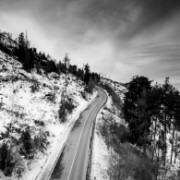Tips for Driving Safely in the Snow
In eight years as a truck driver, Shawn Judge has driven 810,000 miles (accident-free) throughout Ohio, Michigan, and Wisconsin for a beverage distributor. Here’s his advice on how to handle yourself when the snow starts falling:
Relax:
Breathe and stay calm. Panic causes people to overreact. You need to focus.
Slow Down:
Drive only as fast as your abilities and the capabilities of the vehicle permit for the road conditions. If you’re out of practice on snow and ice, slow down. If your tires are bad, slow down. If your car has a low ride height, it won’t handle accumulating snow well. Again, just slow down.
Be Smooth:
Your actions need to be controlled and deliberate. Hard acceleration, hard braking, and sharp curves all decrease traction. Maintain a consistent speed, open up the distance between you and the car ahead, and be easy on the brakes. Steer gently, and remember that inertia will be a factor.
Let There Be Light:
In inclement weather, turn on your headlights. This is so other drivers can see you. Your taillights will be brighter too.
Use Your Signals:
Here’s a trucker’s rule of thumb for lane change: Dry or rainy (not freezing) weather: three blinks, then move over for three blinks. Winter weather: four or five blinks, then move over slowly. Signal for turns before you start slowing down.
If you’re going significantly slower than the traffic around you, turn on your four-way hazards, take the rightmost lane, and just let everyone pass you. The hazards let other drivers know you’re going slower than they are, and this can help prevent a pileup.
Observe Tire Spray:
Pay attention to the water coming off of other vehicles’ tires. If there’s a lot of spray, the roads are wet. If there’s less spray and the road’s wet, take extra caution; the roadway is starting to freeze. If the road looks wet with little or no spray, you’re on black ice. Be extremely cautious.
Watch the Truckers:
When the weather goes south, if the big trucks are slowing down, you should too. If they’re pulling off, perhaps you’d better take a break as well. By no means do I recommend keeping pace with them. (We’re kind of a crazy breed with the advantage of more weight, higher road clearance, more tires, and bigger tires.)
Do Not Stop:
If visibility is zero (i.e., you can’t see beyond your hood), do not stop where you are! You WILL be hit. Creep along until you can safely get your vehicle off and away from the road.
Waiting it Out:
Exit ramps are typically plowed after the main highways. Rest areas are cleared after that. If you need to get off the road, wait it out in the parking lot of a gas station, 24-hour restaurant, or hotel. You stand a better chance of not being snowed in.
Traction is Everything:
Loss of traction in snowy/icy conditions doesn’t happen because you’re on ice. It means you’re hydroplaning on an almost microscopic film of fluid water (in a transitional state) between the ice and the surface of your tires. The lack of cohesion in the fluid gravely reduces friction, which results in less traction.
Make sure you have snow tires or all-weather radials with wide and deep tread valleys. Siping (small cuts that look like squiggly lines) on the tread studs will help with grip on packed snow and ice.
When is Cold-Weather Driving Riskiest?
You face the greatest risk of losing traction on snowy, wet roads when temperatures are between 22 and 35 degrees Fahrenheit. At colder temperatures (10 to 20 degrees or less) snow-covered and icy roads afford more traction than at those warmer (22 to 35 degree) temperatures.
Don’t believe it? Try this: Take two ice cubes. Place one in a deep freezer for 30 minutes. Drop the other in a glass of water. Try picking it in up with your fingertips. Notice how slippery it is? After 30 minutes, get the other ice cube from the freezer. My bet is it practically sticks to your fingers for a bit.
The same principle applies to driving. The ice is almost sticky in more extreme cold. But during heavy and slower traffic, more heat is applied to its surface, and traction will be commensurately reduced.
Ultimately, you’re responsible for exercising your best judgment. If the weather is bad, stay put and let road crews do their jobs.
Be safe out there.




